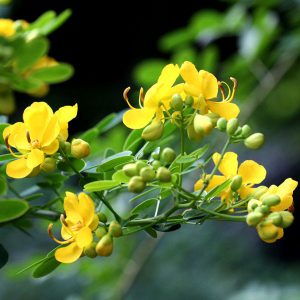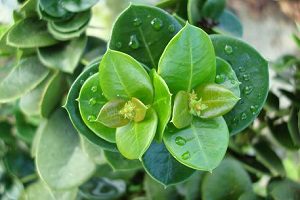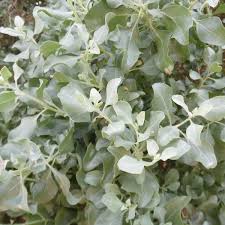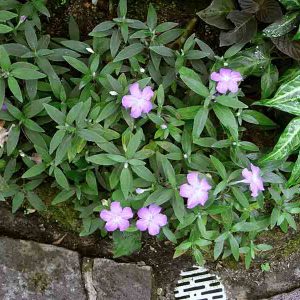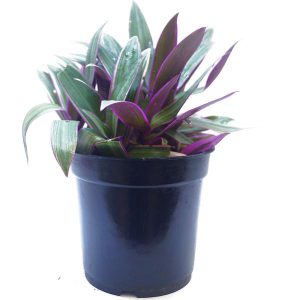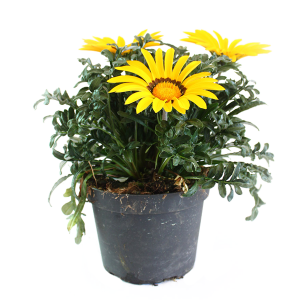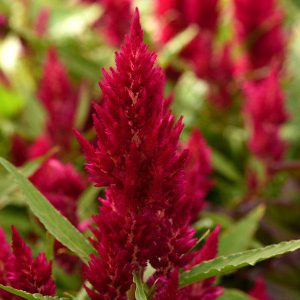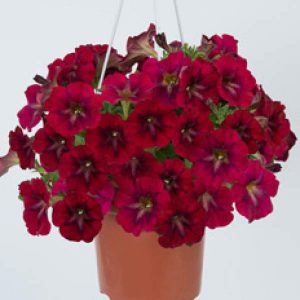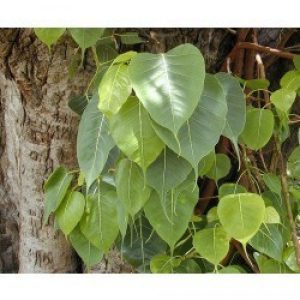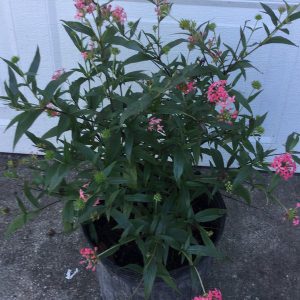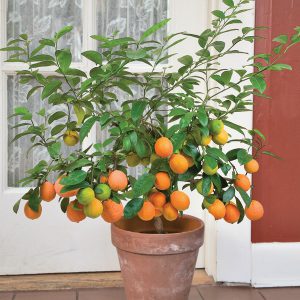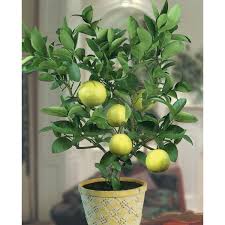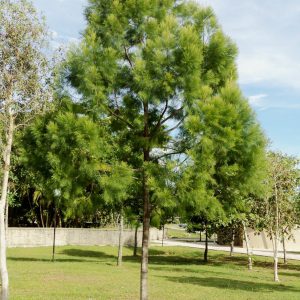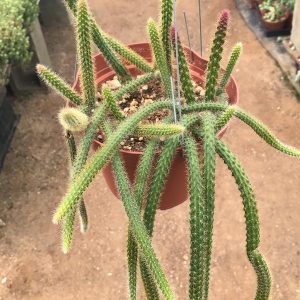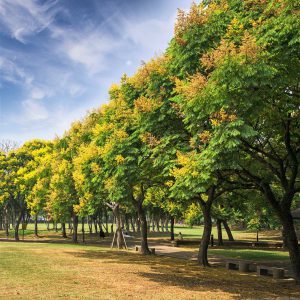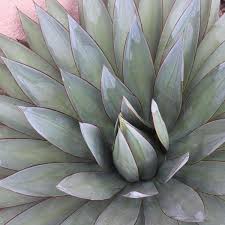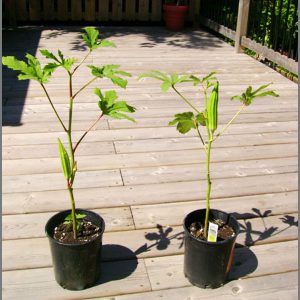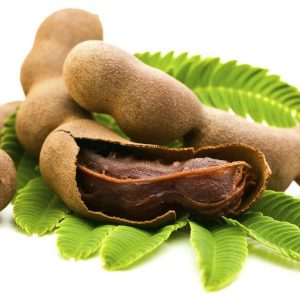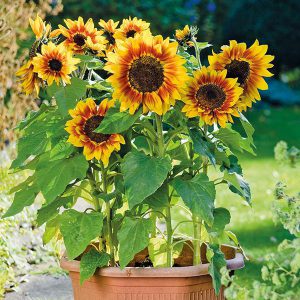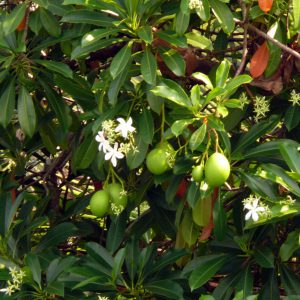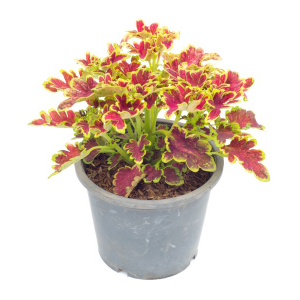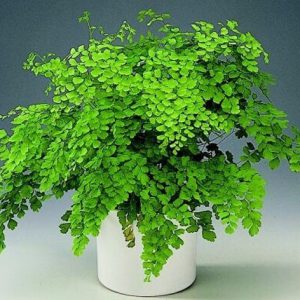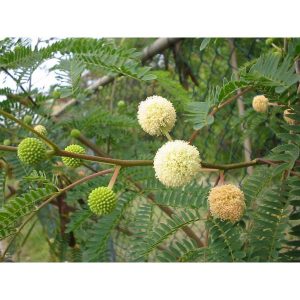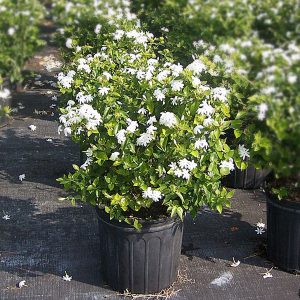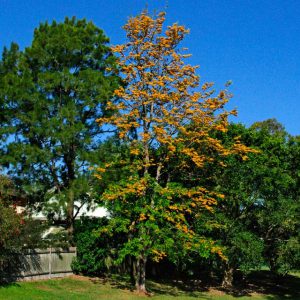Outdoor Plants
Cassia fistula (Golden shower tree)
Young trees can grow asymmetrical with branches often drooping toward the ground. Staking and proper pruning will help develop a well shaped and structured crown.
It has great value in medicine. It is known as aragvadha, meaning “disease killer”. The root is considered a purgative, and self-medication or any use without medical supervision is strongly advised against in Ayurvedic texts. The flesh of the fruit is used as a laxative, while the bark can be used to treat skin infections.
AED 10.00Add to cart
carissa gandiflora boxwood beauty
Carissa ‘Boxwood Beauty’ is a compact dense evergreen shrub with green foliage and no thorns on the stems. Has deep green leaves like a large leafed boxwood. OK to prune heavily to shape. Produces fragrant white flowers with 5 petals. Full sun produces best growth results. Excellent for hedging and shaping
AED 10.00Add to cart
Atriplex halimus
The importance of A. halimus in the functioning of ecosystems is reflected in its promotion of soil biota, while it also acts as a food plant for mammals and arthropods. Its deep root system decreases soil erosion in arid zones, due to stabilisation of the soil. The protein-rich shoot material of A. halimus makes it an important fodder species for livestock, particularly sheep and goats. However, its low energy value means that it should be supplemented with carbohydrate-rich material, such as cereal straw. Potential new uses of this versatile plant species include the phytoremediation of soils contaminated by trace elements and the exploitation of its biomass as a source of renewable energy. Such applications, together with its continued use in low-intensity farming systems, should ensure that A. halimus remains a vital plant species in
AED 10.00Add to cart
Ruellia ciliosa
Easy to care for and great for use as coverage, ruellia plants offer unique beauty to landscape areas. So, what is ruellia and can this Mexican native be cultivated in our own home garden landscape? Keep reading to learn more about growing ruellia.
Ruellia flowers are 2-inch long funnel-shaped blooms growing on a perennial shrub. Originally native to Mexico, it is now found in the Southwest United States, naturalized in many areas. Ruellia flowers from mid spring through the first frosts of fall with purple or blue blooms (on occasion red or pink) on purple stems.
AED 5.00Add to cart
Rhoeo dis colour
Rhoeo, including Rhoeo discolor and Rhoeo spathacea, is a plant of many names. Depending on where you live, you may call this plant moses-in-the-cradle, moses-in-a-basket, boat lily and oyster plant. Whatever you call it, Rhoeo makes an excellent and fast growing ground cover in the garden.
AED 5.00Add to cart
gazania rigens
gazania rigens
Grow in sandy to average, well-drained soils in full sun. Tolerates some soil dryness, but prefers consistent moisture. Do not overwater, however. Deadhead spent flowers to encourage additional bloom. Winter hardy to USDA Zones 9-11. Grow as annuals in St. Louis, either in the ground or in containers. Prefers cool summer climates, and flowering may slow down considerably in hot and humid St. Louis summers. If growing from seed, start plants indoors in late winter (6-8 weeks before last frost date) and set plants outside after last frost date. Take basal offsets from favorite plants in late summer to early fall for rooting and subsequent overwintering indoors in pots. Container plants may also be brought inside for winter.
AED 5.00Add to cart
Celosia
Sunlight: Full sun locations allow cockscomb Celosia to grow taller. But cockscomb may grow in only partial sun, so it can happily exist when partially shaded by taller plants.
Water: Celosia loves moist soil. Although the plant can tolerate short periods of drought but it grows much better when soil remains slightly moist. While watering, remember not to overwater plant to avoid leaf spots, stem rot, root rot and other fungal diseases.
AED 3.00Add to cart
Petunia
Growing petunias can offer long term color in the summer landscape and brighten dreary borders with lovely pastel colors. Proper petunia care is simple and easy. After learning how to plant petunias you can include them in your flower bed and container garden. Four species of petunias include hundreds of cultivars and offer a perfect addition to the home landscape:
AED 2.00Add to cart
ficus religiosa
Grow bodhi trees outdoors in the garden in areas with little or no frost. The National Taiwan University reports that bodhi trees will not survive minimum winter temperatures below 50 degrees Fahrenheit while the Missouri Botanical Garden website states that they are hardy down to 30 degrees F.
AED 0.00Read more
conocarpus erectus var
This low-branching, multi-trunked, shrubby, evergreen tree has beautiful silvery leaves due to silky hairs which cover the leaf surface (Fig. 1). The inconspicuous, small, greenish flowers appear in dense conelike heads in terminal panicles in spring and are followed by 1/2-inch, conelike, red-brown fruits. The dark brown attractive bark is ridged and scaly. The leaves are small and fall between the grass blades of the lawn or are easily washed away in the rain.
AED 0.00Read more
Combacta (carissa grandiiflora) natal plum
Moderate growing evergreen shrub with a rounded growth-habit to 5-8’ tall and wide or larger with age. This durable dense upright-growing species features glossy deep emerald-green foliage accented with an abundance of showy sweetly-fragrant star-shaped pure white flowers that appear predominantly in spring with sporadic bloom throughout the year in milder climates. Following flowering appear 1-2” oval-shaped fruit that ripen to bright-red in summer. This fruit is edible and is popular for jellies and jams as well as being a food source for various bird species. Flowers and fruit are often seen at the same time. This species is armed with rigid forked thorns and makes a formidable barrier. Well-suited as a large background or screen and takes well to shearing making it a good clipped hedge. Tolerates coastal conditions and a variety of soil types provided they’re fast-draining. Drought tolerant once established though a more robust-looking plant will be achieved with regular watering. Full to partial sun.
AED 0.00Read more
Citurs aurantifolia
Seedlings are largely true to type because of polyembryony. The juvenile phase lasts about 5 years. Root suckers and suckers on older branches, characterized by stout sharp spines, are common. Lime is an everbearing tree. Flowers are either perfect or male and borne in inflorescences of up to 10 flowers in the leaf axils of mature shoots, but are often single in the axils of a shoot which has just flushed. The stigma is receptive as the flower opens and remains so for a few days. Pollen is not released until the flower has opened. Copious secretion of nectar by a floral disk attracts insects, especially honey bees, which pollinate the flowers. Self-pollination occurs, but self-incompatibility limits fruit set.
Fruit requires 5.5-6 months from flowering to harvest. In Thailand there is little fruit in March-April. This may be due to early ripening (colouring) of the fruit during the cool dry period of December-February. Alternatively, the gap in supplies may be caused by poor flowering or fruit set during September-October (the second half of the rainy season).
AED 0.00Read more
Casuarina sumatrana (rhu bukit)
Casuarina (Casuarina equisetifolia) belongs to family Casuarinaceae is the most popular farm forestry tree in the coastal lands of Andhra pradesh, Orissa, Tamilnadu, West Bengal, Maharashtra, Gujarat & Karnataka. Casuarina resembles feathery conifer in general appearance. Almost all of the approximately 35 casuarina species produce top-quality firewood. They are rapid-growing, carefree species for sites and climates as varied as coastal sand dunes, high mountain slopes, the hot humid tropics and semi-arid regions. They tend to be salt tolerant, wind resistant and adaptable to moderately poor soils. Although they are not legumes, they do have the ability to form root nodules and fix atmospheric nitrogen.Casuarina equisetifolia can attain heights of 50 m with diameter of around 1 metre. However, it is generally only 15 – 25 metre tall.
AED 0.00Read more
Cactus tail (Rat tail cactus)
Rodents may not be your thing but the easy-to-grow rat tail cactus could be. Aporocactus rat tail cactus is an epiphytic plant, which means it grows naturally in low soil cracks such as tree crotches and rocky crevasses. The plants are native to Mexico which means for the most part growing rat tail cactus is an indoor activity. Gardeners only in the warmer zones can grow them outdoors, but rat tail cactus houseplants thrive in the interior landscape. Rat tail cactus care is uncomplicated and the plants add interest and texture to hanging baskets or succulent containers.
AED 0.00Read more
Albizia lebbeck (rain tree)
The foliage is pale green when young and gray-green at maturity. Flowers are cream colored, hemispheric pom-poms. Seeds germinate well without scarification.
The tree is used as a folk remedy for many ailments. Another common use is as an avenue tree, and sometimes it is used to shade coffee and tea. Saponins and tannins in the bark can be used for making soap and in tanning, respectively. Bee keepers like the species for the light-colored honey its nectar provides, and the tree hosts the lac insect.
AED 0.00Read more
Agave red edge (blue glow)
Smooth, blue-green leaves with yellow-edged, red margins form a single, symmetrical rosette. Each leaf tip bears a short red spine. A comely choice for sunny, low water gardens in warm coastal or humid Mediterranean-like climates. Handsome in dry desert gardens as well, provided some shade and supplemental water. Evergreen.
AED 0.00Read more
Abelmoschus Esculem
Okra is a cultigen (a plant that has been altered by humans through a process of selective breeding). The exact origin of okra is unknown, but it is thought to have come from Africa, where it has been grown as a crop for centuries. Evidence suggests it was grown in Egypt as long ago as 2,000 BC. Today it is widely cultivated for its edible green fruits, which are harvested when immature (after 3-5 days of development), and are infamous for their slimy mucilage.
AED 0.00Read more
Tamarind tree
Tamarind prefers tropical and subtropical, dry and windy climate. It can adapt even to the warm temperate climate, but there it’ll not be very productive. Young plants can’t withstand the cold, while the adults are resistant to temperature till 28 degree Fahrenheit only.
Best planting position is in full sun. For flowering, fruit setting and fruit development, tamarind tree needs clear sky and drier days.
Water saplings deeply when the first inch of soil is dry to the touch. Once established, tamarind trees don’t need watering and can withstand periods of extreme drought conditions without experiencing adverse effects.
Sunflower plant
Sunflowers are one of the most important oil crops in the world, and are a valuable food source in many countries. Just one ounce of sunflower seeds contains about 6 grams of protein and 14 grams of oils. The fats are almost entirely unsaturated with 9g of polyunsaturated and 3g of monounsaturated fats per ounce (NSA). The oil is high in linoleic acid and is a good source of vitamin E.
- While the plant is small, water around the root zone, about 3 to 4 in. from the plant. To protect the plant, it may help to put snail or slug bait around the stem.
- Once the plant is established, water deeply though infrequently to encourage deep rooting. Unless the weather is exceptionally wet or dry, water once a week with several gallons of water.
Pong pong tree (cerbera odollam)
This tree with pretty white star-shaped flowers and large round fruits is widely planted along our roadsides and in our parks. It is also sometimes seen growing wild in our mangroves, seashores and tidal rivers. According to Giesen, it is found in coastal forest and landward margins of mangroves and along rivers. It has a limited salt tolerance, and occurs on clays or sandy soils.
plectranthus scutellariodes
But what is coleus? Sometimes called painted nettle, they are multi-hued, stunning plants grown for their leaves rather than flowers. Excellent for either container gardening or for adoring garden beds, they offer amazing color in partial shaded areas.
Other related species of coleus are used abroad as culinary herbs, medicines, or even for their edible tubers. I’ll briefly touch on a few of those too because they’re interesting, but there’s plenty to see just with Plectranthus scutellarioides.
Hundreds of ornamental coleus cultivars are available, and no two are identical, so let’s get started!
Maidenhair fern fragrance
If you’ve ever grown (or killed) a maidenhair fern, you’ll know that these delicate, lacy beauties are quite picky when it comes to their growing conditions. We’ve featured plenty of tough-as-nails plants (spider plants, Chinese evergreens, cast-iron plants, and dracaena) that can tolerate a wide range of conditions, but maidenhair ferns are the opposite. As long as you know that there’s no fooling around when it comes to meeting its needs, though, this fern will reward you with gorgeous foliage. Here is what you need to know to keep a maidenhair fern thriving.
leucaena leucocephala (white tamarind)
Suitable for: light (sandy), medium (loamy) and heavy (clay) soils and prefers well-drained soil. Suitable pH: acid, neutral and basic (alkaline) soils and can grow in very acid, very alkaline and saline soils.
It cannot grow in the shade. It prefers dry or moist soil and can tolerate drought. The plant can tolerate maritime exposure.
Jasmine (millingtonia hortensis)
The jasmine tree (Millingtonia hortensis) has a number of other common names, including cork tree and nim (in Hindi), because this beautiful tree originates in Asia, and flourishes wild and through cultivation, in India. Its botanical name honors Thomas Millington, an 18th century English botanist. The tree is mainly ornamental in character, tall and graceful, reaching heights of around 80 feet, but not especially hardy, with fairly sparse, brittle branches and bark. However, regular pruning can keep the tree small if desired. The tree’s clusters of delicate, bell-shaped, silver-white flowers bloom in the spring, and again around November and December. They bloom at night and shed their flowers by morning. In India, the flowers are used in religious rituals. New pointed, oval leaves come through in the spring. The jasmine tree is a member of the Bignoniaceae family.
grevillea roobusta (silk oak tree)
This is a fast-growing, single-stemmed, semi-deciduous tree, losing most of its leaves just before flowering. The bark is dark grey and furrowed in a lace-like pattern. The leaves can be over 30 cm long, fern-like, green on the upper surface and pale and silky below. The bright orange flowers are borne in many pairs along flower spikes. The flowers produce plenty of nectar so is very attractive to birds, bees and other insects. Height 25m Spread 15m.

